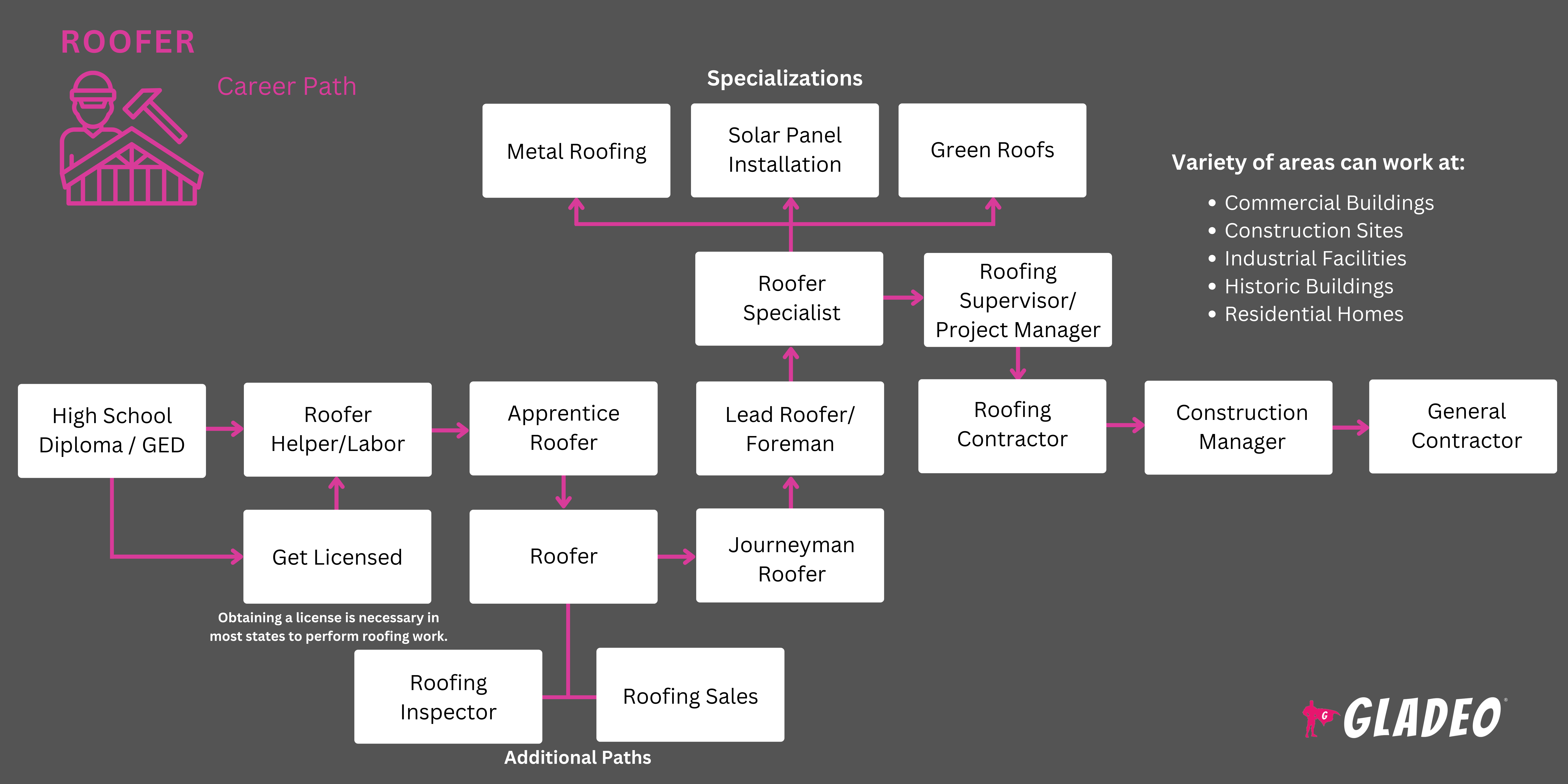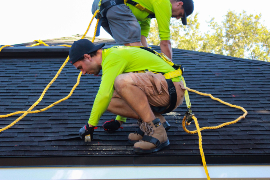聚光灯
商业屋顶工,工业屋顶工,金属屋顶技师,住宅屋顶工,屋顶技师,屋顶服务技术员,屋顶工,屋顶技术员,金属板屋顶工
Buildings are constructed in phases, starting from the bottom foundation and working up to the walls, beams, and other parts of the framework. Next comes the roof — the final piece needed to seal the building and protect the interior from the elements. The roof not only keeps out the rain and wind, it also helps distribute weight evenly across the structure, stabilizing the walls against forces like wind or snow.
Because roofing requires precision and expertise, it’s a job for specialized workers called, you guessed it, Roofers! Roofers use materials like shingles, asphalt, metal, and bitumen to ensure that roofs are weatherproof, energy-efficient, visually appealing, and up to code.
Along with installing new roofs, Roofers also take on the critical tasks of maintaining and repairing older roofs, ensuring the long-term durability of buildings. Since they work at high elevations and with a variety of tools, safety is a top priority to avoid accidents!
- Helping to protect homes and businesses from weather damage
- Working outdoors and staying active
- Opportunities to specialize in different roofing materials and techniques
- Growing demand for energy-efficient and sustainable roofing options
工作日程
Roofers typically work full-time and may experience seasonal fluctuations depending on the weather. Overtime might be necessary during busy periods or emergency repairs.
典型职责
- Meet with stakeholders to determine the requirements, such as installing a roof on a new building or replacing (or repairing) an existing roof)
- Review potential roofing materials, budgets, and project timeframes.
- Take note of the roof measurements of new construction projects. Measure and inspect existing roofs, as needed.
- Estimate the scope of work necessary, including materials, labor, and other costs or special factors such as solar panel installation. Provide quotes to clients, when needed.
- Set up scaffolding and ladders to ensure safe access to roof areas.
- Clear roofs of debris or snow, as needed.
- Remove old or damaged roofing materials, including shingles, tiles, or metal sheets.
- Replace rotting or damaged plywood, joists, and other structural components as needed.
- Install vapor barriers or insulation layers to improve energy efficiency and protect against moisture.
- Install roof ventilation systems, such as ridge vents or turbines, to improve airflow and regulate temperature.
- Align roofing materials precisely with roof edges. Cut materials to fit around chimneys, vents, skylights, and other obstructions.
- Secure roofing materials using nails, screws, or adhesives.
- Attach waterproof flashing strips over joints and seams to create watertight seals.
- Apply roofing cement or caulk to cover exposed nails or screw heads.
Additional Duties
- Install partially overlapping layers of roofing material using chalk lines or other guides for proper alignment.
- Apply protective coatings or membranes to waterproof roofs and prevent water damage.
- Install, repair, or replace single-ply roofing systems made from materials like modified plastics or elastomeric sheets.
- Mop or pour hot asphalt or tar onto flat roofs to create a waterproof base layer.
- Smooth rough or uneven roof surfaces to prepare them for waterproofing treatments or coatings.
- Install skylights or solar panels on roofs, if properly trained to do so.
- Apply gravel or pebbles over the final roof layer to enhance durability.
- Mentor new Roofers. Keep up with new materials and trends.
软技能
- 积极倾听
- 注重细节
- 平衡
- Comfortable with climbing and heights
- 批判性思维
- 客户服务
- 可靠性
- 灵活性
- 独立性
- 监测
- 身体的耐力和力量
- 解决问题
- 项目管理
- 质量保证
- 安全意识
- 团队合作
- 时间管理
技术技能
- Math, such as basic arithmetic to calculate roof area and material needs, geometry to measure angles and slopes, and fractions for cutting materials
- Knowledge of roofing systems and materials like asphalt, metal, and shingles
- Tool proficiency (such as nail guns, roofing hammers, and cutting tools)
- Safety protocols and OSHA standards
- Blueprint reading to understand roof dimensions, angles, and required materials
- Installation techniques for shingles, metal panels, and insulation
- 蓝图阅读
- 估算材料和成本
- 胶粘剂应用知识
- 了解木材因湿度变化而产生的移动
- Residential construction companies
- Roofing contractors
- 政府机构
- Maintenance departments of large facilities
Roofing can be labor-intensive work that involves lifting, climbing, and working at heights – often in hot, cold, or wet weather conditions. They must follow strict safety guidelines to prevent accidents and injuries, making safety consciousness essential.
During the winter season, work may be scarce in areas that have heavy snowfall or too much ice. As a result, Roofers may need to plan ahead financially so they can cover their living expenses during such times.
All in all, the job can be demanding but rewarding for those who enjoy hands-on work and outdoor environments!
Many trends in the roofing industry are focused on energy efficiency and sustainability. For instance, homeowners and businesses are increasingly choosing green roofing options like cool roofs that reflect sunlight to reduce heat absorption and solar roofing systems that integrate photovoltaic panels. These solutions help with energy savings and add long-term value to buildings.
Innovative materials are also changing the game. Roofing systems now use more weather-resistant materials like thermoplastic polyolefin (TPO) and modified bitumen, which offer durability and energy efficiency. Reflective coatings and self-healing materials are extending roof life and reducing the need for frequent repairs.
Safety is improving too, thanks to advanced harnesses and drone technology for safer inspections. Lastly, Roofers are benefiting from digital tools that improve planning and accuracy, ensuring compliance with building codes.
In their younger days, Roofers may have enjoyed hands-on activities, working with tools, and outdoor projects. They might have liked engaging in tasks that required stamina and precision.
- Roofers usually need at least a high school diploma or GED.
- It’s helpful to take courses like tool safety, construction, or roofing techniques in high school, vocational school, trade school, or community college.
- Applicants may be required to have a valid driver’s license so they can get to various work locations on time.
- In some instances, a commercial driver’s license (CDL) may be required, too.
- Most aspiring Roofers start as helpers and receive hands-on training from more experienced workers. Some work and learn via sponsored apprenticeships such as those offered by the United Union of Roofers, Waterproofers & Allied Workers.
- Employers may require new Roofers to complete Occupational Safety and Health Administration safety training or GAF CARE Contractor Training Center courses.
- Note, many states require Roofers to obtain a license at some point in their careers. Licensing options may include a residential license, a commercial license, or a combination license covering both types of work.
- To qualify for a license, Roofers usually must pass a trade exam and provide evidence of completing a certain number of projects within a specific timeframe.
- Proof of liability insurance coverage and a surety bond are other potential requirements to get a license.
- Roofers with experience can apply for certification from the National Roofing Contractors Association PROCertification program.
- Other certifications include the International Institute of Building Enclosure Consultants’ Registered Roof Consultant.
- Consider the cost of tuition, discounts, and local scholarship opportunities (in addition to federal aid).
- Think about your schedule and flexibility when deciding whether to enroll in an on-campus, online, or hybrid program. You’ll need as much hands-on practice as you can get.
- Look closely at the program’s facilities and equipment. Check out the program’s faculty awards and accomplishments.
- Try to read reviews from previous students.
- Review job placement stats and details about the program’s alumni network.
For aspiring Roofers, here’s a helpful guide on the skills and steps to take:
- Take relevant high school courses such as English, general math (arithmetic, fractions, decimals, ratios, proportions), geometry, and physics. Woodworking or shop classes, blueprint reading, and drafting are also valuable.
- High school students can often take community college or vocational training classes simultaneously. Consult your school counselor for details.
- Gain hands-on skills by learning to safely use hand and power tools under the supervision of a professional Roofer.
- Obtain practical work experience through part-time construction jobs, entry-level laborer positions, or apprenticeships.
- Practice by working on roofing projects at home or with friends to get hands-on experience.
- Consider volunteering with organizations like Habitat for Humanity to gain additional experience.
- Expand your roofing knowledge through online classes, instructional videos, or YouTube channels focused on construction skills.
- Educate yourself through roofing-related books, magazines (like Roofing Contractor), blogs, and discussion forums.
- Ask a professional Roofer if they have time for an informational interview to gain insights into the trade.
- Be aware that many employers in the construction industry, including roofing, may conduct pre-employment drug tests to ensure safety in the workplace, especially when using hand and power tools. Some apprenticeships or unions may also require drug testing.

- Rack up as much relevant experience as you can in school or through volunteer work, part-time jobs, or an apprenticeship.
- Check out job portals like Glassdoor, Indeed, USAJOBS, or SimplyHired.
- Look for apprenticeship opportunities at Apprenticeship.gov.
- Screen job ads carefully to ensure you meet the requirements.
- For example, if the job ad lists a driver’s license as a “requirement,” you’ll need to get yours before applying.
- If the job ad lists having a driver’s license as “preferred” or “desired,” you can still apply but ideally should let them know if you’re in the process of getting your license.
- Focus your resume on relevant work and academic experiences.
- Include keywords in your resume/application, such as:
- Flashing Installation
- Flat Roof Systems
- Leak Detection
- Metal Roofing
- Roofing Safety Protocols
- Roof Inspection
- Roof Installation
- Roof Repair
- Shingle Replacement
- Waterproofing
- Review Roofer resume templates to get ideas for formatting and phrasing.
- Look up common Roofer interview questions.
- Ask your school’s career services staff for help with resumes, mock interviews, and job searches. They may have connections to local unions that offer apprenticeships!
- If applying for a union apprenticeship, read the application instructions carefully before filling anything out.
- Note, “most unions don’t expect you to be an expert in your industry,” when you apply for an apprenticeship,” states Indeed.
- Note, many employers in the skilled trades conduct drug tests as a part of their hiring process to reduce risks. Union apprenticeships may also mandate pre-apprenticeship drug tests or random drug tests.
- Reach out to your network to let them know you are looking for opportunities.
- Engage in online forums and ask career advice questions.
- Ask your professors, supervisors, and peers if they’ll serve as personal references.
- 要想面试成功,着装一定要得体!
- Roofers can demonstrate leadership by doing consistently high-quality work, being on-site on time, collaborating effectively with team members, and finishing projects on time and within budget.
- Get licensed, if required by your state and you meet the qualifications.
- Talk to your supervisor about your career goals. Let them know you are willing to knock out any training your employer suggests, such as popular certifications like the National Roofing Contractors Association PROCertification or OSHA 30-Hour Construction training.
- Consider pursuing specialized certifications in areas such as green roofing, metal roofing, or commercial roofing systems.
- Take some advanced GAF CARE Contractor Training Center courses. Ask about tuition reimbursement or other employer-sponsored educational benefits to cover your expenses as you continue learning.
- Gain experience using a variety of roofing materials and keep up to date with new technologies and methods.
- Always prioritize safety and never take shortcuts. One significant mishap or injury could damage your whole career.
- Take courses in project management to handle larger projects and manage budgets, timelines, and personnel more effectively.
- Acquire skills in estimating costs and bidding for projects to qualify for higher-level positions or running a business.
- Learn related trades like waterproofing, insulation, or solar panel installation.
- Familiarize yourself with roofing software and technology tools that streamline project planning, safety compliance, and customer communications.
- Build a professional portfolio showcasing your best work, client testimonials, and safety record.
- Obtain a contractor’s license if needed to access opportunities and higher-paying projects.
- Supervise and mentor junior Roofers. Lead by example and always wear your personal protective equipment when required!
- Keep active in professional organizations like the National Roofing Contractors Association to learn and grow your network.
- If necessary to move up, apply for jobs with larger organizations that may have more advancement potential—or launch your own business.
网站
- Apprenticeship.gov
- 联合建筑商和承包商协会
- 美国总承包商协会
- Bridging Outstanding Opportunities with Tradeswomen Skills
- Career Connections
- GAF
- 从头盔到防护帽
- 房屋建筑商协会
- Job Corps
- 全国住房建筑商协会
- 全国改建业协会
- 全国建筑业工会
- National Roofing Contractors Association
- NCCER
- 职业安全与健康管理局
- Roofing Contractor
- United Union of Roofers, Waterproofers & Allied Workers
书籍
- Roofing the Right Way, by Steven Bolt
- The Complete Guide to Roofing & Siding, by Black & Decker
- The NRCA Roofing Manual, by NRCA
Roofers are vital members of the construction industry, but not everyone wants to work at heights or outside all the time. For those considering hands-on jobs other than roofing, see our list of related careers below!
- 卡朋特
- Ceiling Tile Installer
- 建设和建筑督察
- 建筑工人
- 干墙安装工
- 电工
- Flooring Installer
- 家具整饰工
- 一般维护和修理工人
- 暖通空调技术员
- 绝缘工人
- 泥瓦工
- 模型制作
- 泥水匠
- 钣金工
- 太阳能光伏安装人员
- 金属结构制造和装配工
- Tile and Stone Setter
- 焊工
- 木工机械安装工、操作工和调试工
新闻联播

特色工作

在线课程和工具







